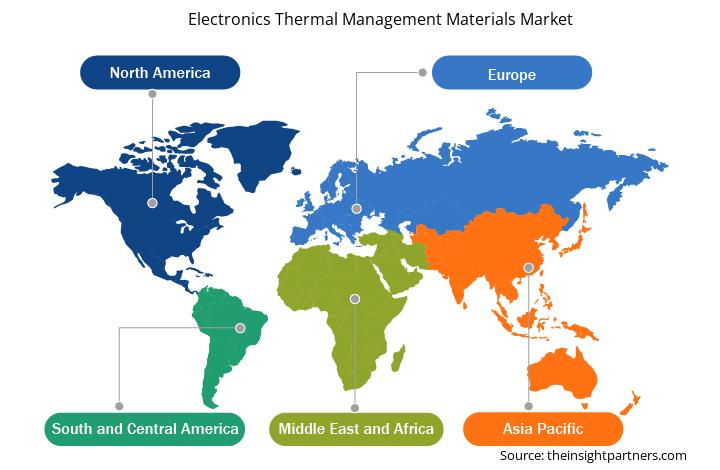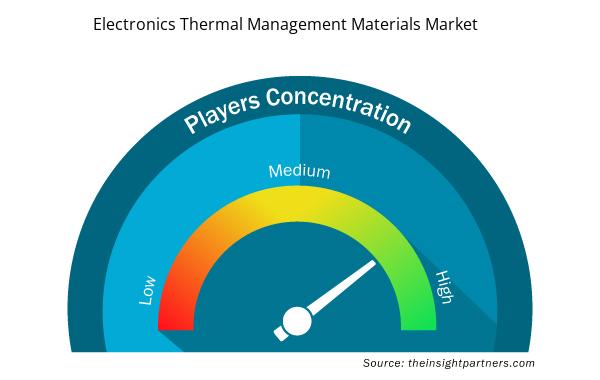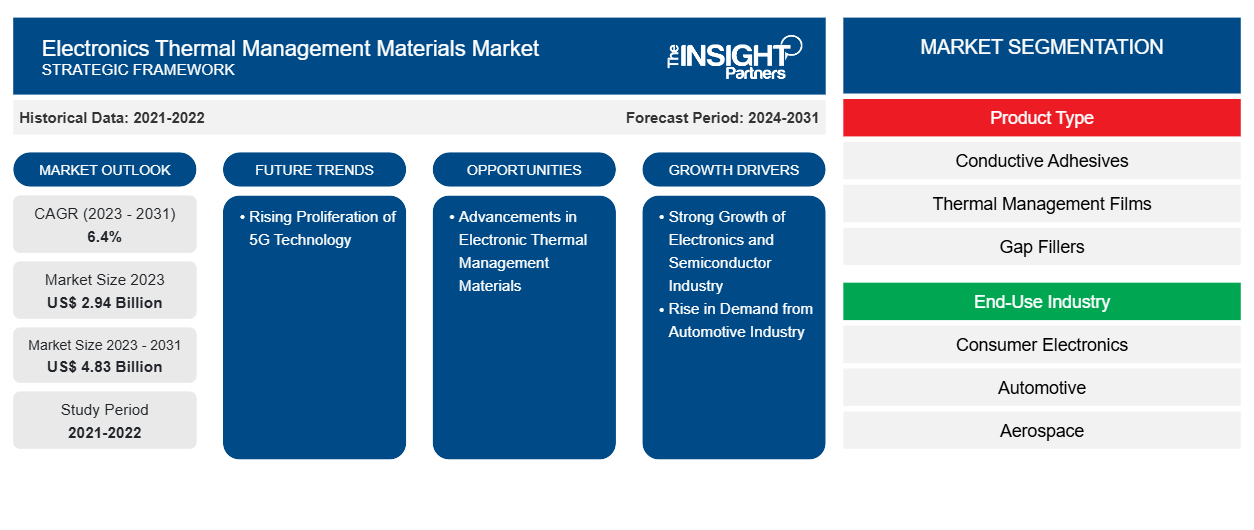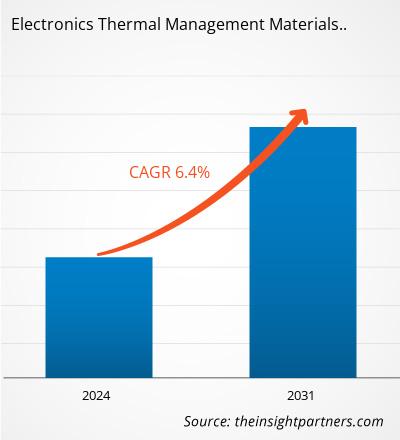電子機器用熱管理材料の市場規模は、2023年の29億4,000万米ドルから2031年には48億3,000万米ドルに達すると予測されています。市場は2023年から2031年の間に6.4%のCAGRを記録すると予想されています。電子機器および半導体業界の力強い成長により、電子機器用熱管理材料は世界中で注目を集めています。
電子機器用熱管理材料市場分析
電子機器の熱管理材料市場は、電子 機器がより強力、コンパクト、熱に敏感になるにつれて、大きな注目を集めています。導電性接着剤、熱ゲル、熱グリース、相変化材料、ヒートスプレッダーなどの熱管理材料は、熱を放散し、電子部品の信頼性と効率を確保する上で重要な役割を果たします。市場の成長は、民生用電子機器、自動車、通信、データセンターなどのセクター全体での需要の増加によって推進されています。特に、電気自動車(EV)と5Gインフラストラクチャの台頭により、過熱を防ぎ、デバイスの寿命を延ばすための高度な熱管理ソリューションの必要性が高まっています。主な課題には、高い熱伝導性、機械的安定性、小型電子機器との互換性を備えた材料の必要性が含まれます。ナノテクノロジーと材料科学の技術的進歩により、グラフェンベースのTIMや高度な相変化材料などの革新的な製品の開発が促進され、パフォーマンスとエネルギー効率が向上しています。
電子機器用熱管理材料市場の概要
電子機器の熱管理材料市場は、民生用電子機器、自動車、通信などの分野での需要増加に牽引され、堅調な成長を遂げています。電子機器がより強力、コンパクト、複雑になるにつれ、部品から発生する熱を管理することが、性能、信頼性、寿命を確保する上で重要になります。熱管理材料は、熱を効率的に放散するように設計されているため、過熱を防ぎ、機器の性能を向上させます。民生用電子機器分野では、スマートフォン、タブレット、ゲーム機などの機器の採用が増えており、効果的な熱管理ソリューションの必要性が高まっています。自動車業界は、特に電気自動車 (EV) や自動運転技術の成長により、効率的な冷却ソリューションを必要とする高出力電子機器を伴うもう 1 つの重要な推進力となっています。さらに、通信業界は、特に 5G インフラストラクチャの拡大に伴い、高性能ネットワーク機器を扱うために高度な熱管理材料に大きく依存しています。
要件に合わせてレポートをカスタマイズする
このレポートの一部、国レベルの分析、Excelデータパックなど、あらゆるレポートを無料でカスタマイズできます。また、スタートアップや大学向けのお得なオファーや割引もご利用いただけます。
- このレポートの主要な市場動向を入手してください。この無料サンプルには、市場動向から見積もりや予測に至るまでのデータ分析が含まれます。
電子機器用熱管理材料市場の推進要因と機会
エレクトロニクスおよび半導体産業の力強い成長
電子機器および半導体産業の急速な拡大は、電子機器用熱管理材料の需要を牽引してきました。電子機器がより強力かつ小型になるにつれ、発生する熱レベルが上昇し、動作効率を維持し、機器の寿命を延ばすために、高度な熱管理ソリューションが必要になります。これらの材料は、スマートフォン、ラップトップ、自動車用電子機器などの機器のプロセッサ、メモリモジュール、パワーエレクトロニクスなどのコンポーネントの熱管理に不可欠です。小型化と性能向上が重要な半導体分野では、過熱を防ぎ、安定した動作を確保するために、効果的な放熱が不可欠になっており、革新的な熱管理材料の需要が高まっています。Invest Indiaによると、世界の電子機器製造サービス市場は、2021年から2026年にかけて5.4%のCAGRで成長し、2026年までに1兆1,450億米ドルに達すると予想されています。インドブランドエクイティ財団は、インドの電子機器製造業界は2025年までに5,200億米ドルに達すると予想していると述べています。さらに、モノのインターネット(IoT)は最近世界中でかなりの人気を集めており、企業は接続性の重要性を認識しています。IoTにより、あらゆるデバイスをインターネットに接続できるようになりました。International Data Corporation(IDC)によると、2025年には416億のIoTデバイスが79.4ゼタバイト(ZB)のデータを生成する能力を持つことになります。
電子熱管理材料の進歩
電子熱管理材料の進歩は、現代の電子機器における増大する熱の課題に対処することで、大きな成長機会を生み出す態勢を整えています。デバイスがより強力でコンパクトになるにつれて、熱伝導率、柔軟性、耐久性が向上した新しい材料は、より高い熱負荷を効果的に管理するために不可欠です。たとえば、グラフェンとカーボンベースの材料の革新は、超高熱伝導率と軽量ソリューションを提供しており、高性能電子機器やEVの用途に最適です。これらの進歩により、メーカーはより効率的でコンパクトな熱ソリューションを設計できるようになり、デバイスのパフォーマンスと寿命が向上します。相変化材料とナノテクノロジーの進歩も、この市場の成長に貢献しています。2024年10月、テキサス大学オースティン校は、冷却要件を13%、データセンター全体のエネルギー使用量を5%節約できる新しい熱インターフェース材料を開発しました。業界全体に適用すれば、大幅な節約になります。研究者によると、冷却はデータセンターのエネルギー使用量の約40%、つまり年間8テラワット時を占めています。この素材は、16平方センチメートルの小さな領域から2,760ワットの熱を除去できます。これにより、電子機器全体の冷却構造の重要な部分である冷却ポンプに必要なエネルギーを65%削減できます。
電子機器熱管理材料市場レポートのセグメンテーション分析
電子機器の熱管理材料市場分析の導出に貢献した主要なセグメントは、製品タイプと最終用途産業です。
- 製品タイプに基づいて、電子機器用熱管理材料市場は、導電性接着剤、熱管理フィルム、ギャップフィラー、熱ゲル、相変化材料、熱グリース、その他に分類されます。熱グリースセグメントは、2023年に最大の市場シェアを占めました。
最終用途産業別に見ると、市場は家電、自動車、航空宇宙、通信、その他に分類されます。2023 年には、自動車部門が市場を支配しました。
電子機器熱管理材料の地域別市場シェア分析
電子機器熱管理材料市場レポートの地理的範囲は、主に北米、アジア太平洋、ヨーロッパ、中東およびアフリカ、南米および中米の 5 つの地域に分かれています。
2023年、アジア太平洋地域は電子機器用熱管理材料市場を支配しました。アジア太平洋地域は、自動車、電子機器、半導体産業の成長により、電子機器用熱管理材料を利用する主要な市場の1つです。この地域には、世界最大の半導体および電子機器の生産国がいくつかあり、韓国、中国、台湾などの国が世界市場をリードしています。中国、インド、韓国などの国では、車両台数の増加によりプリント回路基板(PCB)と半導体の需要が高まり、電子機器用熱管理材料の必要性がさらに高まっています。中国が高度なスキルを持つ製造拠点へと進化するにつれ、韓国、インド、台湾、ベトナムなどの発展途上国は、低~中程度のスキルを持つ製造施設を近隣諸国に移転することを計画している多くの企業を引き付けており、その結果、人件費が削減されています。半導体産業協会の調査によると、世界の半導体生産能力の約75%が東アジアにあります。半導体企業は、この地域での製造活動の開始により、25% ~ 50% のコスト優位性を得ることができます。より強力でコンパクトでエネルギー密度の高い電子機器の開発により、限られたスペース内でかなりの熱が発生するため、これらの機器の性能、信頼性、寿命を維持するには、効果的な熱管理が不可欠です。その結果、熱管理材料は現代の電子機器製造において不可欠な要素となっています。さらに、アジア太平洋地域は、サムスン、ソニー、シャオミなどの大手企業がイノベーションの最前線に立つ、消費者向け電子機器の世界的リーダーです。スマートフォン、タブレット、ウェアラブルなどのポータブルで高性能な機器に対する消費者の需要により、メーカーは、処理能力の高いコンパクトな機器の開発を迫られています。この小型化の傾向により、機器内の熱密度が高まり、より小さなフォームファクターでより高い熱負荷に対応できる高度な熱管理材料を使用する必要があります。アジア全域、特に中国と韓国の電子機器製造施設への投資により、これらのコンパクトで高性能な機器の技術的要求を満たす熱管理ソリューションの採用が加速しています。
電子機器の熱管理材料市場の地域別洞察
予測期間を通じて電子機器用熱管理材料市場に影響を与える地域的な傾向と要因は、Insight Partners のアナリストによって徹底的に説明されています。このセクションでは、北米、ヨーロッパ、アジア太平洋、中東、アフリカ、南米、中米にわたる電子機器用熱管理材料市場のセグメントと地理についても説明します。

- 電子機器用熱管理材料市場の地域別データを入手
電子機器用熱管理材料市場レポートの範囲
| レポート属性 | 詳細 |
|---|---|
| 2023年の市場規模 | 29億4千万米ドル |
| 2031年までの市場規模 | 48.3億米ドル |
| 世界のCAGR(2023年~2031年) | 6.4% |
| 履歴データ | 2021-2022 |
| 予測期間 | 2024-2031 |
| 対象セグメント | 製品タイプ別
|
| 対象地域と国 | 北米
|
| 市場リーダーと主要企業プロフィール |
|
電子機器用熱管理材料市場のプレーヤー密度:ビジネスダイナミクスへの影響を理解する
電子機器用熱管理材料市場は、消費者の嗜好の変化、技術の進歩、製品の利点に対する認識の高まりなどの要因により、エンドユーザーの需要が高まり、急速に成長しています。需要が高まるにつれて、企業は提供品を拡大し、消費者のニーズを満たすために革新し、新たなトレンドを活用し、市場の成長をさらに促進しています。
市場プレーヤー密度とは、特定の市場または業界内で活動している企業または会社の分布を指します。これは、特定の市場スペースに、その市場規模または総市場価値に対してどれだけの競合相手 (市場プレーヤー) が存在するかを示します。
電子機器熱管理材料市場で事業を展開している主要企業は次のとおりです。
- デュポン・ド・ヌムール株式会社
- ヘンケルAG&Co KGaA
- エレクトロルーブ株式会社
- テックマン スペシャリティ マテリアルズ
- モメンティブ・パフォーマンス・マテリアルズ
- 3M社
免責事項:上記の企業は、特定の順序でランク付けされていません。

- 電子機器熱管理材料市場のトップキープレーヤーの概要を入手
電子機器用熱管理材料市場のニュースと最近の動向
電子機器用熱管理材料市場は、主要な企業出版物、協会データ、データベースなどの一次調査と二次調査後の定性的および定量的データを収集することで評価されます。電子機器用熱管理材料市場におけるいくつかの動向を以下に示します。
- モメンティブ テクノロジーズはセラミック粉末会社を買収し、熱伝導材料用の熱充填剤を強化しました。(出典: モメンティブ テクノロジーズ、プレスリリース、2024 年 1 月)
- Heico Companies LLC は、電子機器の冷却技術に関する専門知識を強化するため、電子機器の熱管理の専門企業である Wakefield Solutions Inc を買収しました。(出典: Heico Companies LLC、プレスリリース、2023 年 2 月)
- ダウとカーバイスは、モビリティ、産業、消費者、半導体など、さまざまな業界の高性能電子機器向けに、複数世代の熱伝導性インターフェース材料を提供するための戦略的パートナーシップを結びました。(出典:ダウ、プレスリリース、2023年10月)
電子機器用熱管理材料市場レポートの対象範囲と成果物
「電子機器用熱管理材料市場の規模と予測(2021~2031年)」レポートでは、以下の分野をカバーする市場の詳細な分析を提供しています。
- 電子機器の熱管理材料の市場規模と予測(対象範囲に含まれるすべての主要市場セグメントについて、世界、地域、国レベルで)
- 電子機器用熱管理材料市場の動向、および推進要因、制約、主要な機会などの市場動向
- ポーターの5つの力とSWOT分析の詳細
- 主要な市場動向、世界および地域の枠組み、主要プレーヤー、規制、最近の市場動向を網羅した電子機器熱管理材料市場分析
- 市場集中、ヒートマップ分析、主要プレーヤー、電子機器熱管理材料市場の最近の動向を網羅した業界展望と競争分析
- 詳細な企業プロフィール
- 過去2年間の分析、基準年、CAGRによる予測(7年間)
- PEST分析とSWOT分析
- 市場規模価値/数量 - 世界、地域、国
- 業界と競争環境
- Excel データセット


- Vessel Monitoring System Market
- Occupational Health Market
- Extracellular Matrix Market
- Diaper Packaging Machine Market
- Nurse Call Systems Market
- Public Key Infrastructure Market
- Smart Mining Market
- Hair Extensions Market
- Biopharmaceutical Contract Manufacturing Market
- Batter and Breader Premixes Market

Report Coverage
Revenue forecast, Company Analysis, Industry landscape, Growth factors, and Trends

Segment Covered
This text is related
to segments covered.

Regional Scope
North America, Europe, Asia Pacific, Middle East & Africa, South & Central America

Country Scope
This text is related
to country scope.
よくある質問
The rapid expansion of the electronics and semiconductor industry has been a key driver of demand for electronic thermal management materials. As electronic devices become more powerful and compact, they generate higher heat levels, necessitating advanced thermal management solutions to maintain operational efficiency and extend device lifespan.
In the automotive industry, electronic thermal management materials have become increasingly vital as vehicles evolve to incorporate more advanced electronic systems, particularly with the surge in electric vehicles (EVs) and hybrid models. These materials are essential for ensuring the optimal performance, safety, and reliability of electronic components that generate substantial heat during operation, such as power electronics, battery packs, electric motor controllers, infotainment systems, and advanced driver-assistance systems (ADAS).
An increasing number of on-fleet vehicles in countries such as China, India, and South Korea propels the demand for printed circuit boards (PCBs) and semiconductors, further bolstering the need for electronic thermal management materials. With China's evolution into a high-skilled manufacturing hub, developing countries such as South Korea, India, Taiwan, and Vietnam are attracting several businesses that plan to relocate their low to medium-skilled manufacturing facilities to neighboring countries, which results in reduced labor costs.
Based on product type, the electronics thermal management materials market is segmented into conductive adhesives, thermal management films, gap fillers, thermal gels, phase change materials, thermal greases, and others. In 2023, the thermal greases segment held the largest market share. Thermal greases, also known as thermal pastes or thermal compounds, are highly effective materials used to enhance heat transfer between heat-generating components and their cooling solutions, such as heat sinks or spreaders.
Advancements in electronic thermal management materials act as a significant future opportunity for the market. Advancements in electronic thermal management materials are poised to create significant growth opportunities by addressing the increasing thermal challenges in modern electronics. As devices become more powerful and compact, new materials with enhanced thermal conductivity, flexibility, and durability are essential to manage the higher heat loads effectively.
The major players operating in the global electronic thermal management materials market are DuPont de Nemours Inc, Henkel AG & Co KGaA, Electrolube Ltd, Tecman Speciality Materials Ltd, Momentive Performance Materials Inc, 3M Co, European Thermodynamics Ltd, Honeywell International Inc, Parker Hannifin Corp, Wacker Chemie AG, Sur-Seal Corp, Graco Inc, Robnor ResinLab Ltd, Master Bond Inc, and Marian Inc.
Trends and growth analysis reports related to Chemicals and Materials : READ MORE..
The List of Companies - Electronic Thermal Management Material Market
- DuPont de Nemours Inc
- Henkel AG & Co KGaA
- Electrolube Ltd
- Tecman Speciality Materials Ltd
- Momentive Performance Materials Inc
- 3M Co
- European Thermodynamics Ltd
- Honeywell International Inc
- Parker Hannifin Corp
- Wacker Chemie AG
- Sur-Seal Corp
- Graco Inc
- Robnor ResinLab Ltd
- Master Bond Inc
- Marian Inc
The Insight Partners performs research in 4 major stages: Data Collection & Secondary Research, Primary Research, Data Analysis and Data Triangulation & Final Review.
- Data Collection and Secondary Research:
As a market research and consulting firm operating from a decade, we have published and advised several client across the globe. First step for any study will start with an assessment of currently available data and insights from existing reports. Further, historical and current market information is collected from Investor Presentations, Annual Reports, SEC Filings, etc., and other information related to company’s performance and market positioning are gathered from Paid Databases (Factiva, Hoovers, and Reuters) and various other publications available in public domain.
Several associations trade associates, technical forums, institutes, societies and organization are accessed to gain technical as well as market related insights through their publications such as research papers, blogs and press releases related to the studies are referred to get cues about the market. Further, white papers, journals, magazines, and other news articles published in last 3 years are scrutinized and analyzed to understand the current market trends.
- Primary Research:
The primarily interview analysis comprise of data obtained from industry participants interview and answers to survey questions gathered by in-house primary team.
For primary research, interviews are conducted with industry experts/CEOs/Marketing Managers/VPs/Subject Matter Experts from both demand and supply side to get a 360-degree view of the market. The primary team conducts several interviews based on the complexity of the markets to understand the various market trends and dynamics which makes research more credible and precise.
A typical research interview fulfils the following functions:
- Provides first-hand information on the market size, market trends, growth trends, competitive landscape, and outlook
- Validates and strengthens in-house secondary research findings
- Develops the analysis team’s expertise and market understanding
Primary research involves email interactions and telephone interviews for each market, category, segment, and sub-segment across geographies. The participants who typically take part in such a process include, but are not limited to:
- Industry participants: VPs, business development managers, market intelligence managers and national sales managers
- Outside experts: Valuation experts, research analysts and key opinion leaders specializing in the electronics and semiconductor industry.
Below is the breakup of our primary respondents by company, designation, and region:

Once we receive the confirmation from primary research sources or primary respondents, we finalize the base year market estimation and forecast the data as per the macroeconomic and microeconomic factors assessed during data collection.
- Data Analysis:
Once data is validated through both secondary as well as primary respondents, we finalize the market estimations by hypothesis formulation and factor analysis at regional and country level.
- Macro-Economic Factor Analysis:
We analyse macroeconomic indicators such the gross domestic product (GDP), increase in the demand for goods and services across industries, technological advancement, regional economic growth, governmental policies, the influence of COVID-19, PEST analysis, and other aspects. This analysis aids in setting benchmarks for various nations/regions and approximating market splits. Additionally, the general trend of the aforementioned components aid in determining the market's development possibilities.
- Country Level Data:
Various factors that are especially aligned to the country are taken into account to determine the market size for a certain area and country, including the presence of vendors, such as headquarters and offices, the country's GDP, demand patterns, and industry growth. To comprehend the market dynamics for the nation, a number of growth variables, inhibitors, application areas, and current market trends are researched. The aforementioned elements aid in determining the country's overall market's growth potential.
- Company Profile:
The “Table of Contents” is formulated by listing and analyzing more than 25 - 30 companies operating in the market ecosystem across geographies. However, we profile only 10 companies as a standard practice in our syndicate reports. These 10 companies comprise leading, emerging, and regional players. Nonetheless, our analysis is not restricted to the 10 listed companies, we also analyze other companies present in the market to develop a holistic view and understand the prevailing trends. The “Company Profiles” section in the report covers key facts, business description, products & services, financial information, SWOT analysis, and key developments. The financial information presented is extracted from the annual reports and official documents of the publicly listed companies. Upon collecting the information for the sections of respective companies, we verify them via various primary sources and then compile the data in respective company profiles. The company level information helps us in deriving the base number as well as in forecasting the market size.
- Developing Base Number:
Aggregation of sales statistics (2020-2022) and macro-economic factor, and other secondary and primary research insights are utilized to arrive at base number and related market shares for 2022. The data gaps are identified in this step and relevant market data is analyzed, collected from paid primary interviews or databases. On finalizing the base year market size, forecasts are developed on the basis of macro-economic, industry and market growth factors and company level analysis.
- Data Triangulation and Final Review:
The market findings and base year market size calculations are validated from supply as well as demand side. Demand side validations are based on macro-economic factor analysis and benchmarks for respective regions and countries. In case of supply side validations, revenues of major companies are estimated (in case not available) based on industry benchmark, approximate number of employees, product portfolio, and primary interviews revenues are gathered. Further revenue from target product/service segment is assessed to avoid overshooting of market statistics. In case of heavy deviations between supply and demand side values, all thes steps are repeated to achieve synchronization.
We follow an iterative model, wherein we share our research findings with Subject Matter Experts (SME’s) and Key Opinion Leaders (KOLs) until consensus view of the market is not formulated – this model negates any drastic deviation in the opinions of experts. Only validated and universally acceptable research findings are quoted in our reports.
We have important check points that we use to validate our research findings – which we call – data triangulation, where we validate the information, we generate from secondary sources with primary interviews and then we re-validate with our internal data bases and Subject matter experts. This comprehensive model enables us to deliver high quality, reliable data in shortest possible time.


 このレポートの無料サンプルを入手する
このレポートの無料サンプルを入手する